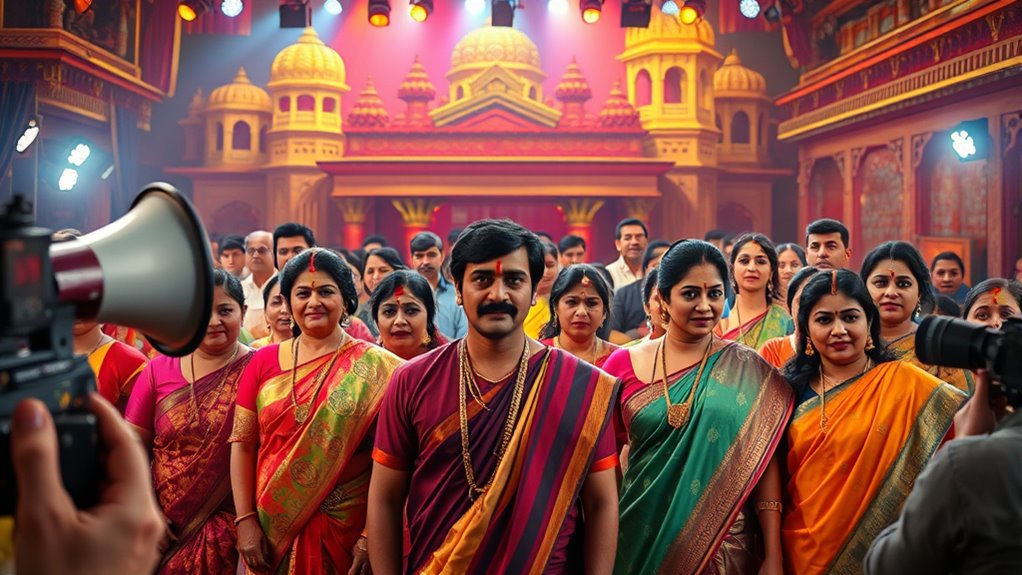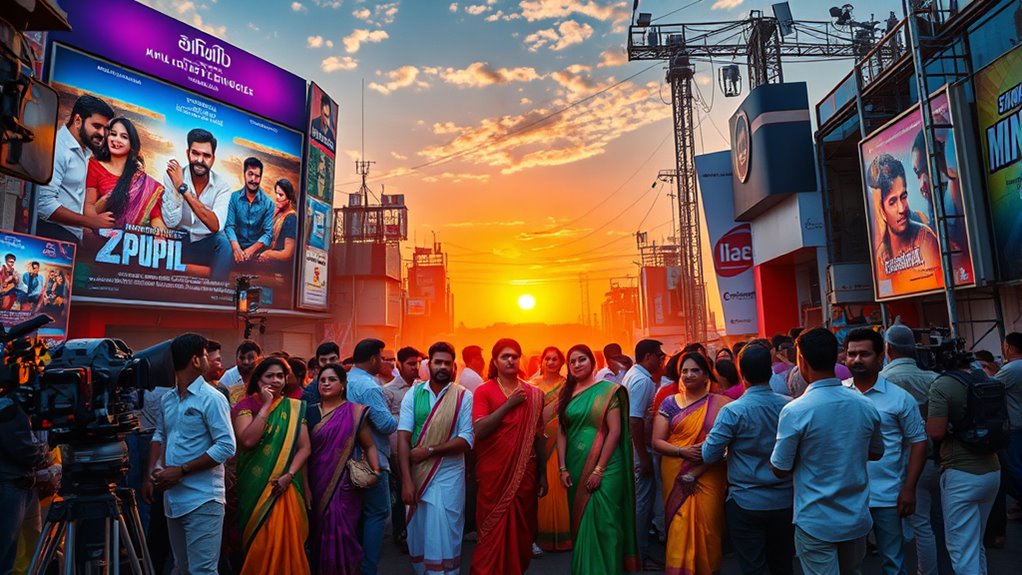South Indian remakes are increasingly taking over Bollywood, reflecting changing audience preferences. These films often succeed because of their strong storytelling, innovative visuals, and regional appeal, but many miss the mark when they lack cultural adaptation or originality. While some remakes become huge hits, others flop due to high expectations or cultural disconnect. If you want to understand whether this trend is here to stay or fading, there’s more to explore behind the scenes.
Key Takeaways
- South Indian remakes often attract audiences with proven stories but may lack originality, leading to mixed reviews.
- Successful remakes depend on cultural adaptation, strong casting, and effective marketing strategies.
- South Indian films like *Baahubali* and *KGF* have set high standards, influencing Bollywood’s remake trends.
- Many remakes fail due to cultural disconnect, poor execution, or failure to bring fresh perspectives.
- The trend is shifting towards more original content, with South Indian films inspiring innovative Bollywood projects.
The Evolution of South Indian Films in Bollywood

The evolution of South Indian films in Bollywood reflects a dynamic process of cultural exchange and industry adaptation. For decades, regional cinema influenced Bollywood through remakes, especially in the 1980s, with Tamil movies inspired by Amitabh Bachchan’s hits and Rajinikanth’s performances. Early on, Bollywood underestimated regional cinema’s potential, but the trend reversed when Hindi filmmakers began adapting South Indian hits, starting with films like *Ramudu Bheemudu* (1964). Kamal Haasan’s work helped showcase South Indian storytelling’s impact on Bollywood, highlighting the importance of regional cinema’s influence on national trends. Over time, this exchange became more reciprocal, with Bollywood increasingly recognizing South Indian films’ commercial appeal and technical prowess. Today, remakes and inspirations flow both ways, reflecting a vibrant cultural dialogue that shapes Indian cinema’s evolving landscape. The role of visual technology has also contributed to the global appeal of these films, allowing for higher quality remakes and adaptations. The increasing use of advanced filmmaking techniques has further bridged the gap between regional and mainstream cinema, fostering a more integrated industry. As a result, the industry dynamics continue to evolve, fostering greater integration and innovation across regional and mainstream Indian cinema.
Why Some Remakes Fail to Impress

Remakes often struggle to impress audiences because they rely heavily on familiarity rather than offering fresh storytelling. You may find yourself feeling deja vu, as many remakes simply rehash the original without adding new ideas. This often leads to disinterest, especially when the story lacks originality or cultural resonance. Additionally, cultural differences can make South Indian films less relatable for North Indian viewers. Relying solely on star power doesn’t guarantee success if the narrative doesn’t connect. Audiences today prefer innovative, original content and are quick to notice when a remake falls short. You might also notice that poor marketing and high expectations set by the original can amplify disappointment. Ultimately, failure to adapt culturally and creatively causes many remakes to miss their mark. Remake failures can also result from a lack of understanding of regional nuances, which can make the story feel disconnected from local audiences. Moreover, production quality and adherence to the original’s essence can significantly impact the remake’s reception. Recognizing the importance of cultural resonance in storytelling is crucial for remake success. Incorporating local cultural elements thoughtfully can help make remakes more relatable and engaging for diverse audiences. Furthermore, understanding the audience preferences for authenticity and originality is essential for creating successful remakes that resonate deeply.
The Rise of South Indian Cinema and Its Impact

Over the past decade, South Indian cinema has experienced a remarkable surge in growth, marked by bigger budgets, higher box office earnings, and expanding audience reach. Regional films like *Baahubali*, *KGF*, and *Pushpa* have set new box office records, attracting viewers across India and internationally through dubbing and subtitles. With high-quality storytelling, innovative narratives, and strong performances, South Indian films have built a reputation for excellence. They often outperform Bollywood releases in regional markets and sometimes even nationally. OTT platforms further boost their reach, making these films accessible to diverse audiences. This surge has influenced Bollywood, which now looks to South Indian hits for remakes and inspiration, shifting market dynamics and audience preferences towards more original, compelling content.
Key Elements Behind Successful Remakes

Successful Bollywood remakes hinge on several key elements that determine their appeal and longevity. First, a strong original script is essential, as compelling stories attract audiences. Second, understanding market demand ensures the remake resonates with current preferences. Third, casting well-known stars can notably boost interest and visibility. Fourth, cultural adaptation is vital for making the story relatable to the new audience. To succeed, focus on:
- Crafting authentic stories with emotional depth
- Aligning with audience tastes and trends
- Selecting the right cast to amplify appeal
- Respecting cultural nuances for genuine connection
These elements help remakes stand out, sustain interest, and avoid falling into repetition. When executed well, they can turn a familiar story into a fresh, engaging experience for viewers. Effective marketing strategies also play a crucial role in reaching wider audiences and ensuring box office success.
Future Outlook: Trends and Challenges Ahead

Looking ahead, Bollywood’s remake landscape is set to evolve as both opportunities and obstacles emerge. You’ll see a greater emphasis on originality, as audiences demand fresh stories, making remakes more challenging. Debutant directors are bringing unique perspectives, potentially reshaping how remakes are crafted. The influence of successful South Indian films like *RRR* will continue to guide remake choices, with a shift toward more nuanced and culturally adapted versions. Meanwhile, audience preferences for regional content will grow, impacting remake strategies. Additionally, cultural sensitivity will become increasingly important, as filmmakers strive to respect diverse storytelling styles while catering to a broader audience. This evolution will also require a deeper understanding of regional narratives, which can help in creating authentic and resonant remakes. As the popularity of South Indian cinema continues to rise, Bollywood may need to adapt its approach to incorporate regional influences more seamlessly. Moreover, the rise of regional storytelling styles highlights the importance of understanding diverse cultural contexts in filmmaking. A well-researched approach to remaking regional hits can significantly enhance authenticity. However, challenges like stiff competition from original blockbusters, high audience expectations, and the need for cultural sensitivity remain. Balancing creative freedom with market demands will be essential, ensuring remakes stay relevant and profitable in a rapidly evolving industry. The increasing popularity of South Indian cinema exemplifies this trend, encouraging Bollywood to innovate while respecting regional storytelling styles.
Frequently Asked Questions
How Do Cultural Differences Affect the Success of Remakes?
Cultural differences greatly impact the success of remakes because they influence how well the story resonates with audiences. You may find that South films rely on local humor, traditions, and language, which can get lost or feel out of place in a broader Hindi context. When these nuances aren’t adapted thoughtfully, viewers may feel disconnected, leading to mixed reviews. Successful remakes bridge cultural gaps, balancing authenticity with appeal.
What Role Does Star Power Play in Remake Success?
Star power plays a significant role in Bollywood remake success by boosting marketing and creating buzz. When you see big stars attached, it often attracts more audience interest and media coverage. However, recent trends show that star wattage alone doesn’t guarantee box office hits anymore. Instead, audiences now value originality, storytelling, and cultural authenticity more, making star power a helpful but not decisive factor in a remake’s overall success.
Are Original South Indian Films Overshadowed by Bollywood Remakes?
You might think that original South Indian films are overshadowed by Bollywood remakes, but that’s not entirely true. While remakes often get more visibility nationally, original films are gaining recognition through streaming platforms and international film festivals. Your support for authentic storytelling helps these films stand out, preserve their cultural roots, and build loyal audiences. So, even amidst remakes, original South Indian movies are carving their own space and recognition.
How Does Audience Fatigue Influence Remake Viewership?
Did you know that over 60% of viewers feel overwhelmed by the sheer volume of remakes? Audience fatigue makes you pickier, so you often skip familiar stories. When overexposed, remakes lose their appeal, especially if they lack fresh, cultural relevance or strong marketing. You’re more likely to seek original content or innovative adaptations, making it harder for remakes to attract and hold your attention.
What Are the Key Challenges in Adapting Regional Nuances?
When adapting regional nuances, you face several key challenges. You struggle to capture the authentic storytelling style, often resorting to direct translations that don’t resonate with Hindi audiences. Preserving cultural context and humor proves difficult, leading to dilution of original richness. Casting authentic regional actors is hard, and scripts lose their linguistic flavor in translation. These issues make it tough to create a remake that feels genuine, risking audience disconnect and criticism.
Conclusion
As South Indian remakes continue to carve their niche in Bollywood’s tapestry, you’re witnessing a dance of shadows and light—some hits, some misses. Like a river carving new paths through familiar terrain, these films reshape expectations and challenge norms. Embrace the waves of change, but remember, every splash leaves ripples. With every attempt, the industry grows bolder, forging a future where innovation and tradition collide in a mesmerizing symphony of cinematic evolution.









